Plot
"Gold" is a man created using genetic engineering. The object was to produce a person of high intelligence with superhuman reflexes and muscular coordination. He leads an unfulfilled life, despite having become rich and famous, including a career as a concert pianist. He lacks real companionship, and is certain that he is sterile and cannot have children. He is widely regarded as a playboy who has wasted his potential.
Gold lives in America, in a world governed by the United Nations. Humanity has been under attack by an extraterrestrial race they know only as Exterminators, having never seen an individual. The conflict has resulted in one of the enemy ships crashing on the Moon. The sole survivor is a humanoid giant, who was brain-damaged due to lack of oxygen. Evidently the Exterminators are a race of giants. Compared to them, humans are about the size of a large insect.
The Russians also have a genetic superman, Pavel Petrovna. He has built a capsule inside the giant's head, with the ability to control its body's movements from a keyboard while observing the world through one of the eyes. Petrovna himself is deformed, with arms and legs too short for his body. Only Gold has the ability to operate the controls. The plan is for Gold and Petrovna to be installed in the capsule inside the giant, and await rescue. The giant will be taken back to his home world, allowing the humans to gain intelligence about their attackers.
When Petrovna is killed in an accident on the Moon, the project has to go ahead with his assistant and lover, Marina Syerov, who initially despises Gold.
Flashbacks in the narrative also tell of Gold's upbringing in a research facility, particularly his teenage years when he was found to be sterile despite his strong sexual appetites, and the emotional impact of that discovery.
As the story progresses, Gold comes to appreciate the culture of the giants, as well as discovering that he is not sterile after all, his genetic makeup simply making him slower to mature than humans. Having fathered a child with Marina, he now has a different set of priorities in his life.
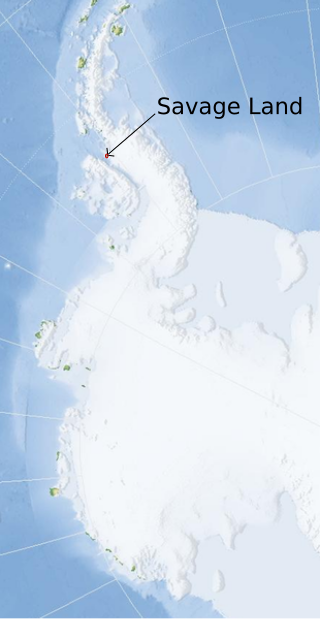
The Savage Land is a hidden prehistoric land that features in American comic books published by Marvel Comics. It is a tropical preserve hidden in Antarctica. It has appeared in many story arcs in Uncanny X-Men as well as other related books.
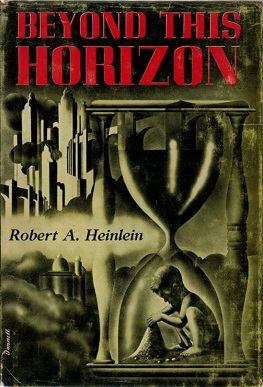
Beyond This Horizon is a science fiction novel by American writer Robert A. Heinlein. It was originally published as a two-part serial in Astounding Science Fiction and then as a single volume by Fantasy Press in 1948. It was awarded a Retro-Hugo award for best novel in 2018.
The term superhuman refers to humans, human-like beings or beings with qualities and abilities that exceed those naturally found in humans. These qualities may be acquired through natural ability, self-actualization or technological aids. The related concept of a super race refers to an entire category of beings with the same or varying superhuman characteristics, created from present-day human beings by deploying various means such as eugenics, euthenics, genetic engineering, nanotechnology, and/or brain–computer interfacing to accelerate the process of human evolution.

A humanoid is a non-human entity with human form or characteristics. The earliest recorded use of the term, in 1870, referred to indigenous peoples in areas colonized by Europeans. By the 20th century, the term came to describe fossils which were morphologically similar, but not identical, to those of the human skeleton.
The concept of self-replicating spacecraft, as envisioned by mathematician John von Neumann, has been described by futurists including physicist Michio Kaku and has been discussed across a wide breadth of hard science fiction novels and stories. Self-replicating probes are sometimes referred to as von Neumann probes. Self-replicating spacecraft would in some ways either mimic or echo the features of living organisms or viruses.
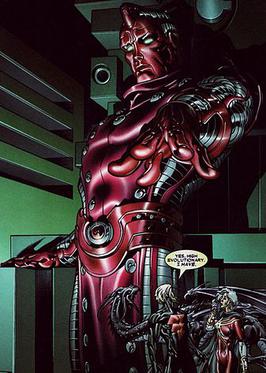
The High Evolutionary is a fictional character appearing in American comic books published by Marvel Comics. He is depicted as a scientist who seeks to evolve different life forms such as the New Men. The High Evolutionary's goals have often put him at odds with different superheroes.
The concept of a mutant is a common trope in comic books and science fiction. The new phenotypes that appear in fictional mutations generally go far beyond what is typically seen in biological mutants and often result in the mutated life form exhibiting superhuman abilities or qualities.
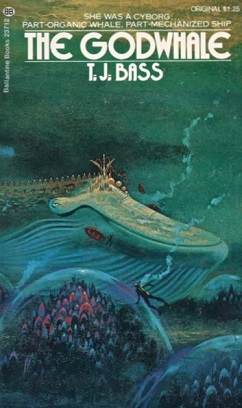
The Godwhale is a science fiction novel by American novelist T. J. Bass, first published in 1974. It is the sequel to Half Past Human. The book was nominated for the Nebula Award for Best Novel in 1974. The novel deals with genetic and biological inventions with a strange and mystical twist.

Destrii or the Primatrix Destriianatos, is a fictional character who appeared in the Doctor Who Magazine comic strip based on the long-running British science fiction television series Doctor Who. She was a companion of the Eighth Doctor.
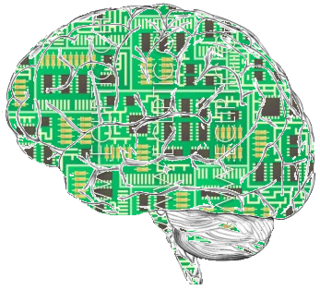
Mind uploading, whole brain emulation, or substrate-independent minds, is a use of a computer or another substrate as an emulated human brain. The term "mind transfer" also refers to a hypothetical transfer of a mind from one biological brain to another. Uploaded minds and societies of minds, often in simulated realities, are recurring themes in science-fiction novels and films since the 1950s.

Roswell Conspiracies: Aliens, Myths & Legends is an animated television series that originally aired as part of BKN's cartoon programing block. The show's premise was that aliens had been living among humans for ages, and were the origins of many of the creatures humans know from myth, folklore and legends, including vampires and werewolves. The show was produced in part of BKN's drive to reinvent itself as a children's block and company in general.

Artificial intelligence is a recurrent theme in science fiction, whether utopian, emphasising the potential benefits, or dystopian, emphasising the dangers.
Hidden races are fictional races of humanoid creatures appearing in American comic books published by Marvel Comics. The Earth of Marvel's main continuity has contained a number of fictional hidden native humanoid races.

AI takeover—the idea that some kind of artificial intelligence may supplant humankind as the dominant intelligent species on the planet—is a common theme in science fiction. Famous cultural touchstones include Terminator and The Matrix.
This page is based on this
Wikipedia article Text is available under the
CC BY-SA 4.0 license; additional terms may apply.
Images, videos and audio are available under their respective licenses.









